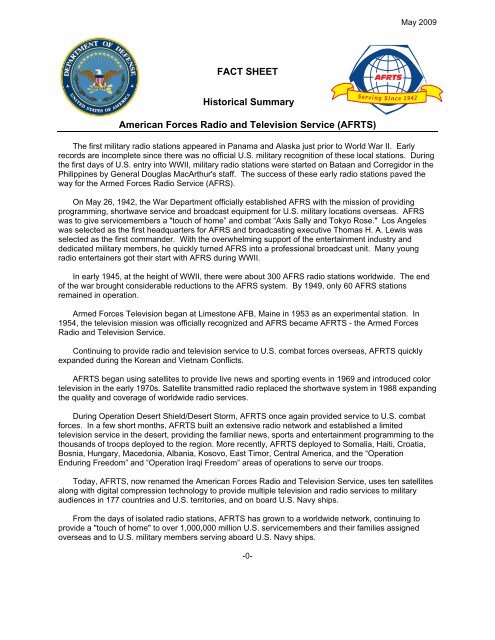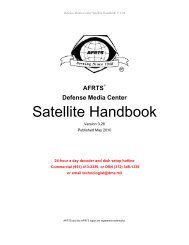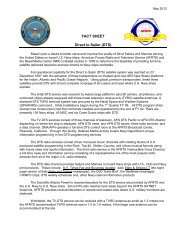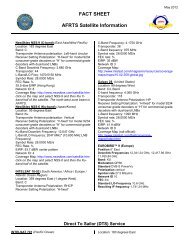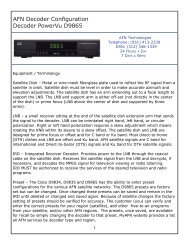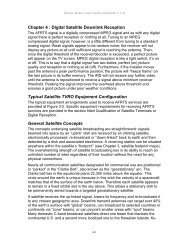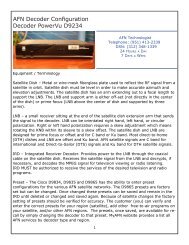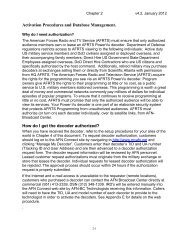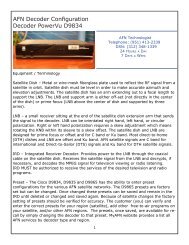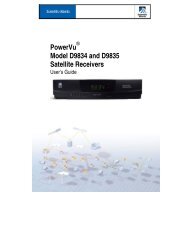American Forces Information Service February 1998 - afrts
American Forces Information Service February 1998 - afrts
American Forces Information Service February 1998 - afrts
You also want an ePaper? Increase the reach of your titles
YUMPU automatically turns print PDFs into web optimized ePapers that Google loves.
FACT SHEET<br />
Historical Summary<br />
<strong>American</strong> <strong>Forces</strong> Radio and Television <strong>Service</strong> (AFRTS)<br />
S e r v i n g Since 1942<br />
May 2009<br />
The first military radio stations appeared in Panama and Alaska just prior to World War II. Early<br />
records are incomplete since there was no official U.S. military recognition of these local stations. During<br />
the first days of U.S. entry into WWII, military radio stations were started on Bataan and Corregidor in the<br />
Philippines by General Douglas MacArthur's staff. The success of these early radio stations paved the<br />
way for the Armed <strong>Forces</strong> Radio <strong>Service</strong> (AFRS).<br />
On May 26, 1942, the War Department officially established AFRS with the mission of providing<br />
programming, shortwave service and broadcast equipment for U.S. military locations overseas. AFRS<br />
was to give servicemembers a "touch of home” and combat “Axis Sally and Tokyo Rose." Los Angeles<br />
was selected as the first headquarters for AFRS and broadcasting executive Thomas H. A. Lewis was<br />
selected as the first commander. With the overwhelming support of the entertainment industry and<br />
dedicated military members, he quickly turned AFRS into a professional broadcast unit. Many young<br />
radio entertainers got their start with AFRS during WWII.<br />
In early 1945, at the height of WWII, there were about 300 AFRS radio stations worldwide. The end<br />
of the war brought considerable reductions to the AFRS system. By 1949, only 60 AFRS stations<br />
remained in operation.<br />
Armed <strong>Forces</strong> Television began at Limestone AFB, Maine in 1953 as an experimental station. In<br />
1954, the television mission was officially recognized and AFRS became AFRTS - the Armed <strong>Forces</strong><br />
Radio and Television <strong>Service</strong>.<br />
Continuing to provide radio and television service to U.S. combat forces overseas, AFRTS quickly<br />
expanded during the Korean and Vietnam Conflicts.<br />
AFRTS began using satellites to provide live news and sporting events in 1969 and introduced color<br />
television in the early 1970s. Satellite transmitted radio replaced the shortwave system in 1988 expanding<br />
the quality and coverage of worldwide radio services.<br />
During Operation Desert Shield/Desert Storm, AFRTS once again provided service to U.S. combat<br />
forces. In a few short months, AFRTS built an extensive radio network and established a limited<br />
television service in the desert, providing the familiar news, sports and entertainment programming to the<br />
thousands of troops deployed to the region. More recently, AFRTS deployed to Somalia, Haiti, Croatia,<br />
Bosnia, Hungary, Macedonia, Albania, Kosovo, East Timor, Central America, and the “Operation<br />
Enduring Freedom” and “Operation Iraqi Freedom” areas of operations to serve our troops.<br />
Today, AFRTS, now renamed the <strong>American</strong> <strong>Forces</strong> Radio and Television <strong>Service</strong>, uses ten satellites<br />
along with digital compression technology to provide multiple television and radio services to military<br />
audiences in 177 countries and U.S. territories, and on board U.S. Navy ships.<br />
From the days of isolated radio stations, AFRTS has grown to a worldwide network, continuing to<br />
provide a "touch of home" to over 1,000,000 million U.S. servicemembers and their families assigned<br />
overseas and to U.S. military members serving aboard U.S. Navy ships.<br />
-0-
FACT SHEET<br />
<strong>American</strong> <strong>Forces</strong> Radio and Television <strong>Service</strong> (AFRTS)<br />
Keeping our troops overseas informed and entertained<br />
S e r v i n g Since 1942<br />
May 2009<br />
The AFRTS mission is to communicate Department of Defense (DoD) information to the internal<br />
audience via U.S. television and radio news, information and entertainment programming targeted to U.S.<br />
service members, DoD civilians and their families stationed or deployed overseas and aboard U.S. Navy<br />
ships.<br />
The AFRTS vision is to provide a “touch of home” to DoD personnel wherever they are serving<br />
overseas through U.S. television and radio news, information and entertainment programs.<br />
Best of all<br />
The <strong>American</strong> <strong>Forces</strong> Network (AFN), a service of AFRTS, provides the best of all <strong>American</strong><br />
television in a unique mix of programs seen stateside on broadcast networks of NBC, CBS, ABC, FOX,<br />
CW, PBS, and major cable channels. Different AFN services are carefully designed to serve different<br />
audiences, or to give the audience more choice, rather than compete for the same audience.<br />
Using space age technology to send the signal<br />
AFRTS uses two state-of-the-art distribution networks: one is called the Satellite Network or SATNET;<br />
and the other is the Direct-to-Sailor or DTS. These satellite networks distribute live and recorded television and<br />
radio programming worldwide.<br />
Bringing troops a touch of home<br />
Through the generous cooperation of U.S. performing guilds, unions, and federations (dating back to<br />
World War II), AFRTS is not charged performance rights or residual fees for programming. That allows<br />
program owners and syndicators to make their products available to AFRTS free of charge, or at a fraction of<br />
the cost that would be paid by commercial radio or television stations.<br />
Programs are provided to the AFRTS overseas audience through land-based outlets or directly via<br />
satellite to homes and deployed ships. Some land-based outlets are organized as networks to serve specific<br />
geographic areas.<br />
<strong>American</strong> <strong>Forces</strong> Network Broadcast Center (AFN-BC), part of the Defense Media Activity (DMA),<br />
is located at March Air Reserve Base in Riverside, California, and is the sole programming source for<br />
military radio and television outlets overseas. These outlets serve <strong>American</strong> service men and women,<br />
Department of Defense (DoD) civilians, and their families stationed in 177 countries and U.S. territories and<br />
aboard U.S. Navy ships at sea with much of the same programming available to stateside audiences.<br />
Programs are uplinked from AFN-BC to a series of satellites and delivered worldwide via secure digital<br />
transmission paths using MPEG-2 digital compression technology.<br />
AFRTS programs are distributed without censorship, propagandizing, or manipulation in<br />
accordance with DoD Directive 5120.20 and DoD Regulation 5120-20R. While program content is<br />
unchanged, AFRTS is commercial-free; therefore, all commercials are deleted and replaced with AFN<br />
program promotional announcements, DoD internal information and other public service spot<br />
announcements of interest to DoD personnel and their family members.
Programming Acquisition<br />
May 2009<br />
All entertainment, news, sports and information programming is acquired and distributed by AFN-<br />
BC based on its scheduling needs, the popularity of programs within the specific DoD audience<br />
demographics, and unique interests of military audiences. All religious programs are selected and<br />
approved by the Armed <strong>Forces</strong> Chaplains Board.<br />
Television Programming <strong>Service</strong>s<br />
There are eight AFN television services, all of which originate at the AFRTS Broadcast Center in<br />
Riverside, California. They are AFN|prime, AFN|news, AFN|sports, AFN|spectrum, AFN|family, AFN|movie<br />
AFN|xtra, and the AFN|program guide. A ninth service, The Pentagon Channel, is produced by<br />
Department of Defense Public Affairs in Alexandria, Virginia, and is distributed along with the AFN services.<br />
Receiving AFN Television<br />
The great majority of overseas military bases are capable of receiving and distributing all AFRTS<br />
television services by using U.S. Government or commercial on-base cable TV systems or direct-to-home<br />
satellite reception equipment. Some areas are served by a low-power over-the-air transmitter and receive<br />
only one service, AFN|prime. Most Operation Enduring Freedom and Operation Iraqi Freedom locations<br />
receive all AFN TV services while a few receive only one or two over-the-air services, usually AFN|news<br />
and AFN|sports. Navy ships equipped with a Direct-to-Sailor (DTS) satellite dish receive AFN|prime,<br />
AFN|news and AFN|sports services. Program scheduling information is available online at www.myafn.net.<br />
AFN <strong>Service</strong>s<br />
Provides the familiar patterns of a traditional broadcast network affiliate. It has news and<br />
information in the morning, daytime dramas and syndicated game and talk shows during the morning and<br />
afternoon; popular current network dramas, sitcoms, reality series, and movies in primetime; and late night<br />
talk shows. Locally and regionally produced news is also inserted in some prime services on weekdays.<br />
Weekend schedules carry some live and tape-delayed sports events at times when alternate entertainment<br />
programming is available on AFN|spectrum, as well as some children’s programming. AFN|prime is timeshifted<br />
for three specific geographical locations – Pacific (Japan/Korea), Atlantic (Europe) and Southwest<br />
Asia (Iraq/Afghanistan.<br />
Provides counter-programming to AFN|prime with popular entertainment programs from the major<br />
broadcast and cable networks. AFN|spectrum offers an alternate entertainment choice with a combination<br />
of popular, first-run network shows as well as encore presentations of established hits. AFN|spectrum is<br />
time-shifted for two specific geographical locations – Atlantic (Europe) and Pacific (Japan/Korea).<br />
Provides a wide variety of quality entertainment…the freshest most popular kids programming from<br />
U.S. cable and broadcast networks…targeted specifically to family members between the ages of 2 and<br />
17. Each day part is designed for a different age group, ranging from pre-school to teen viewers.<br />
2
AFN|family is time-shifted for two specific geographical locations – Atlantic (Europe) and Pacific<br />
(Japan/Korea).<br />
May 2009<br />
Provides news when you want it, anytime, any day. This is a full-time news and information service<br />
with programming primarily from ABC, CBS, CNN, FNC, MSNBC, NBC and PBS. Additionally, you’ll find<br />
news and public affairs programming about the Department of Defense and the Military <strong>Service</strong>s provided<br />
by The Pentagon Channel and the news organizations within the Military <strong>Service</strong>s. AFN|news is the<br />
primary means for the AFRTS audience to stay in touch with national and international events and general<br />
military information.<br />
Provides a wide variety of sports programming based on the interests of the AFRTS military<br />
audience. This full-time sports and sports-news service features programming from major sports sources<br />
like ESPN, FSN, FX, OLN, Speed, TBS and TNT, along with national and international sports coverage<br />
from the broadcast networks of ABC, CBS, NBC and FOX. It provides the most popular sports events such<br />
as MLB, NASCAR, NBA, NCAA football and basketball, NFL, NHL, Olympic Winter and Summer Games<br />
and the PGA Tour.<br />
Provides a wide variety of theatrical and made-for-TV movies, specials, along with entertainment<br />
news and features sure to please the Hollywood fan. Primarily targeted to adults, ages 18 and older.<br />
Theatrical features conform to domestic <strong>American</strong> over-the-air broadcast standards. AFN|movie is timeshifted<br />
for two specific geographical locations – Atlantic (Europe) and Pacific (Japan/Korea).<br />
AFN|xtra takes you on and off the field with a highly-targeted blend of sports events, Emmy-award winning<br />
talk shows and unscripted series, action sports, and videogaming programming. AFN|xtra is your<br />
destination for around-the-clock top professional and collegiate sports events every weekend and brings<br />
you top rated personality-driven programming and reality-based series during the week. Home of the Emmy<br />
and Peabody Award-winning The Daily Show with Jon Stewart along with Best Damn Sports Show Period,<br />
The Contender, World Series of Poker and the widely popular UFC, WWE Smackdown! and RAW<br />
franchises, AFN|xtra brings you big name athletes, celebrities, and comedians with topical sports and<br />
entertainment news, trends, youth culture and current events, while getting you inside the fast-paced<br />
worlds of action sports and videogaming.<br />
The Pentagon Channel broadcasts 24 hours a day, 7 days a week via a U.S. domestic satellite to<br />
stateside bases and on AFRTS to service members stationed overseas. The Pentagon Channel is<br />
available to all U.S. Department of Defense bases/installations for airing on their base/installation cable<br />
systems, and to anyone wishing to receive it via satellite on the DISH Network and on a number of<br />
commercial cable systems in the continental United States. (Please see more detail in separate fact<br />
sheet.)<br />
3
Radio Programming <strong>Service</strong>s<br />
4<br />
May 2009<br />
Radio news, information, and sports talk. The Broadcast Center distributes a primary radio service<br />
consisting of international, international, national and military radio news, commentary and and talk talk radio programs. This This<br />
service is provided 24-hours per day, seven days a week by by satellite and shortwave. Programs are<br />
provided provided by by U.S. U.S. radio networks and and suppliers including ABC, CBS, CNN, ESPN, ESPN, FOX, National Public<br />
Radio (NPR), Associated Press Radio Network, Premier Radio Network, Westwood One, Jones Radio, Air<br />
America and USA Radio Network. In addition, AFN Radio provides a full-time news and features channel, a<br />
full-time full-time NPR channel, and two sports talk channels. AFN affiliated stations are provided news copy from from<br />
the radio wires of AP News.<br />
Radio entertainment. The The AFRTS AFRTS Broadcast Center distributes radio entertainment entertainment programs<br />
acquired from commercial and public radio radio networks and and syndicators. AFRTS AFRTS provides seven seven music music<br />
formats ranging from from country to to hard rock. rock. Additionally, a weekly supply of new CDs is mailed to each<br />
AFRTS land-based land-based and Navy shipboard outlet containing containing the most most popular new new recordings in various various music<br />
formats formats for use use by by outlets in producing local radio programs.<br />
Shortwave: Shortwave: The AFN Voice Channel is broadcast worldwide by a network of shortwave radio<br />
transmitters operated by by the U.S. U.S. Navy Navy at Pearl Harbor, Key West, Diego Garcia and Guam.<br />
-0-
FACT SHEET<br />
AFRTS Satellite Network (SATNET)<br />
S e r v i n g Since 1942<br />
May 2009<br />
In 1969, the <strong>American</strong> <strong>Forces</strong> Radio and Television <strong>Service</strong> (AFRTS) was among the first<br />
organizations to use satellites as a means of transmitting television programming. Today, AFRTS provides<br />
radio and television programming by satellite 24 hours-a-day, to 177 countries and U.S. territories.<br />
Using an Intelsat Galaxy satellite, AFRTS provides satellite service to the U.S. base in Honduras and<br />
the Naval Base at Guantanamo Bay, Cuba. Additionally, this satellite provides connectivity for the network’s<br />
Atlantic and Pacific satellites.<br />
Using an Intelsat satellite over the Atlantic Ocean, AFRTS serves DoD personnel in Africa, the Middle<br />
East, and on the islands of Diego Garcia, Iceland and the Azores (Portugal).<br />
Korea.<br />
In the Pacific, two SES New Skies satellites carry the AFRTS signal to DoD personnel in Japan and<br />
A satellite superstation concept is used in the European Hemisphere to deliver regional radio and<br />
television services. In Germany and Italy, the <strong>American</strong> <strong>Forces</strong> Network-Europe (AFN-E) uplinks to two<br />
Eutelsat HotBird satellites which are received at sites throughout Europe, North Africa, the Middle East, and<br />
many parts of Southwest Asia.<br />
All AFRTS satellite transmissions use the Scientific-Atlanta PowerVu ® digital compression system to<br />
allow the transmission of multiple channels of television and radio services over a single satellite transponder.<br />
This system employs digital conditional access encryption to protect the programming from being received by<br />
unauthorized audiences. SATNET provides full-time, live, radio and television services from the United<br />
States to service members, DoD civilians, and their families serving overseas.<br />
-0-
May 2009
FACT SHEET<br />
AFRTS DIRECT-TO-HOME SERVICE (Europe)<br />
S e r v i n g Since 1942<br />
May 2009<br />
Since December of <strong>1998</strong>, the European Command (EUCOM), the Army and Air Force Exchange<br />
<strong>Service</strong> (AAFES), the Naval Exchange Command (NEXCOM), and AFRTS have jointly sponsored a satellite<br />
direct-to-home (DTH) service for service members, DoD civilian employees and their family members living off<br />
base in the EUCOM area of operation (minus Central and Southern Africa).<br />
Using two powerful Eutelsat Communications Hotbird transponders, AFRTS delivers nine television<br />
services, a program guide, and 12 radio services that are received in the European area with an 80- centimeter<br />
satellite dish and an integrated receiver/decoder (IRD). Both the dish and the IRD are available through most<br />
European AAFES and NEXCOM stores. The IRD can be either leased or purchased. Some commands have<br />
purchased IRDs and dishes for issue to off-base military and DoD civilian employee households.<br />
At the beginning of the DTH program, EUCOM estimated that there were approximately 50,000<br />
households living off base in their theater of operation, and almost all of these households were able to receive<br />
either just one over-the-air AFRTS television service or no service at all. As of January 2008, some 32,000<br />
IRDs have been leased or purchased through the European and Southwest Asia AAFES and NEXCOM stores.<br />
Hotbird 9
FACT SHEET<br />
AFRTS DIRECT-TO-HOME SERVICE (Pacific)<br />
S e r v i n g Since 1942<br />
May 2009<br />
Since September of 2002, the U.S. Pacific Command (PACOM), the Army and Air Force Exchange<br />
<strong>Service</strong> (AAFES), the Navy Exchange <strong>Service</strong> Command (NEXCOM), and AFRTS have jointly sponsored a<br />
satellite direct-to-home (DTH) service for service members, DoD civilian employees and their family members<br />
living off-base in Japan and Korea. In late 2005, PACOM added a quality of life and situational awareness<br />
program in Japan that provides their off-base personnel a free loaner decoder during their tour. Decoders are<br />
available at military exchanges for lease only in Korea.<br />
Using an SES News Skies satellite over the Pacific Ocean, AFRTS delivers nine television services, a<br />
program guide, and 12 radio services that are received in Japan and Korea with a 60cm or 80cm satellite dish<br />
(depending on location) and an integrated receiver/decoder (IRD). Both the dish and the IRD are available<br />
through most of Japan and Korea AAFES, NEXCOM and MCX stores. In Japan, the Housing Office<br />
Furnishings Management Office on each installation makes this equipment available to eligible viewers living off<br />
base without charge. As of May 2009, more than 7,700 IRD have been issued by housing furniture offices in<br />
Japan.<br />
PACOM estimated that there were approximately 16,000 off-base households that received only one<br />
over-the-air AFRTS television service or no service at all. With Pacific exchange stores leasing decoders and<br />
Japan-based members offering loaner decoders while living off base, all families can now be served with the full<br />
complement of AFRTS television and radio services. As of May 2009, 2,700 IRDs have been leased by<br />
households in Japan and Korea.<br />
New Skies 6<br />
For more information, please see www.myafn.net
FACT SHEET<br />
Direct to Sailor (DTS)<br />
S e r v i n g Since 1942<br />
May 2009<br />
Based upon a desire to better serve and improve the quality of life of Sailor and Marines serving<br />
the United States on board U.S. Navy ships, <strong>American</strong> <strong>Forces</strong> Radio and Television <strong>Service</strong> (AFRTS) and<br />
the Naval Media Center (NMC) initiated studies in 1995 to determine the feasibility of providing full-time,<br />
satellite delivered television services directly to Navy ships worldwide.<br />
Full operational capability for the Direct to Sailor (DTS) satellite system was reached on 23<br />
December 1997 with the activation of three transponders on Intelsat (and now SES New Skies) platforms<br />
for the Indian, Atlantic and Pacific Ocean Regions. Using global, premium transponders, these three<br />
satellites provide DTS with almost complete coverage of all oceans and seas where U.S. Navy ships<br />
operate.<br />
The initial DTS service was received by twenty large platforms (aircraft carriers, amphibious, and<br />
command ships) already equipped with three-meter television receive-only (TVRO) satellite antennas. A<br />
standard DTS TVRO terminal system was procured by the Naval Space and Warfare Systems (SPAWARS)<br />
command. Initial installations began during the 1 st Quarter FY 99. All DTS program ships (except new<br />
construction) had their terminals installed and operational by the end of FY 02. There are presently 138<br />
Navy ships, 45 MSC and six Coast Guard ships with DTS.<br />
The TV-DTS services consist of three channels of television, AFN DTS Pacific or AFN DTS Atlantic<br />
depending on where the ship is deployed, AFN DTS news, and AFN DTS sports, three radio services, and<br />
a data channel. NMC operates a full-time DTS control room at the AFRTS Broadcast Center, Riverside,<br />
California. Through this facility, Defense Media Activity-Anacostia inserts Navy Department unique<br />
information programming in the DTS programming services.<br />
The DTS radio services consist of two monaural music channels with rotating blocks of U.S.<br />
produced satellite programming in the Rock, Top-40, Oldies, Country, and Urban musical formats along<br />
with hourly news and sports information. The third radio service is the AFRTS Interruptible Voice Channel,<br />
a full-time news and information service consisting of a representative mix of the most popular radio<br />
services from all of the major U.S. radio networks.<br />
The DTS data channel provides Sailor and Marines on board Navy ships with U.S., DoD and Navy<br />
print products. These include: N.Y. Times Fax and Business Update; daily Stars & Stripes LT (the eight<br />
page version of daily Stars and Stripes newspaper); the DoD “Early Bird”; the NavNews (message);<br />
CHINFO Clips; DTS weekly schedules and, other Navy internal information products.<br />
The Scientific-Atlanta PowerVu receiver/decoders for the DTS service are provided by AFRTS and<br />
the U.S. Navy to U.S. Navy ships. Since DTS also reaches land areas beyond the AFRTS SATNET<br />
footprints, AFRTS provides receiver/decoders to remote land based sites where U.S. military members are<br />
stationed.<br />
Worldwide, the TV-DTS service can be received with a TVRO antenna as small as 1.2 meters but<br />
the AFRTS recommended TVRO antenna size is 1.5 to 1.8 meters, if the larger size antenna can be<br />
accommodated at the site.
May 2009<br />
USS Ships should refer all questions concerning the satellite dish and the antenna control unit (ACU) to<br />
their Regional Maintenance Center (RMC). For questions concerning below deck DTS support equipment<br />
USS ships should contact their local Navy Fleet Support Detachment (FSD). Questions concerning future<br />
installation of shipboard DTS equipment on USS Navy Ships should be referred to SPAWARS Systems<br />
<strong>Service</strong> Center, San Diego (SSC – San Diego). MSC and US Coast Guard Ships should contact their Port<br />
Engineer for any questions concerning the DTS satellite dish and it's ACU. For questions concerning the<br />
below deck supportive equipment they should contact their local NMC FSD for support and/or SITE for<br />
equipment exchanges. For any future installation questions contact DMA Anacostia Afloat Engineering<br />
Division, Washington DC<br />
-0-
May 2009
NOTES:<br />
RADIO<br />
Afghanistan<br />
Bahrain<br />
Belgium<br />
Bosnia-Herzegovina<br />
Cuba (Guantanamo Bay)<br />
Diego Garcia (BIOT)<br />
Egypt (Sinai)<br />
Germany<br />
Greece (Crete)<br />
Honduras<br />
Iraq<br />
Italy<br />
Japan (including Okinawa)<br />
Kosovo<br />
Kuwait<br />
Kyrgyzstan<br />
Marshall Islands<br />
Netherlands<br />
Norway<br />
Pakistan<br />
Portugal (Azores)<br />
Qatar<br />
Saudi Arabia<br />
South Korea<br />
Spain<br />
Turkey<br />
FACT SHEET<br />
<strong>American</strong> <strong>Forces</strong> Radio & Television <strong>Service</strong><br />
(AFRTS)<br />
Over-the-Air Transmitters<br />
TELEVISION<br />
Afghanistan<br />
Belgium<br />
Cuba (Guantanamo Bay)<br />
Diego Garcia (BIOT)<br />
Egypt (Sinai)<br />
Germany<br />
Greece (Crete)<br />
Honduras<br />
Iraq<br />
Japan (including Okinawa)<br />
Kosovo<br />
Kuwait<br />
Marshall Island (Kwajelein)<br />
Portugal (Azores)<br />
South Korea<br />
S e r v i n g Since 1942<br />
May 2009<br />
(1) Most TV transmitters are low power, NTSC format, with directional antenna patterns serving<br />
only a local U.S. military audience.<br />
(2) Radio transmitters may be FM or AM and vary by country. www.myafn.net
Afghanistan*<br />
Albania<br />
Algeria<br />
<strong>American</strong> Samoa<br />
Angola<br />
Antarctica<br />
Antigua<br />
Argentina<br />
Armenia<br />
Ascension Island<br />
Australia<br />
Austria<br />
Azerbaijan<br />
Bahamas<br />
Bahrain*<br />
Bangladesh<br />
Barbados<br />
Belarus<br />
Belgium*<br />
Belize<br />
Benin<br />
Bolivia<br />
Bosnia-Herzegovina<br />
Botswana<br />
Brazil<br />
Brunei<br />
Bulgaria<br />
Burkina Faso<br />
Burma<br />
Burundi<br />
Cambodia<br />
Cameroon<br />
Cape Verde<br />
Central African<br />
Republic<br />
Chad<br />
Chile<br />
China<br />
Columbia<br />
Congo, Dem Republic of the<br />
Congo, Republic of the<br />
Costa Rica<br />
Cote d’Ivoire<br />
Croatia<br />
AFRTS Outlets<br />
Cuba*<br />
Cyprus<br />
Czech Republic<br />
Denmark<br />
Diego Garcia*<br />
Dominican Republic<br />
Djibouti<br />
Ecuador<br />
Egypt<br />
El Salvador<br />
Equatorial Guinea<br />
Eritrea<br />
Estonia<br />
Ethiopia<br />
Fed. States of<br />
Micronesia<br />
Fiji<br />
Finland<br />
France<br />
Gabon<br />
Gambia<br />
Georgia<br />
Germany*<br />
Ghana<br />
Greece<br />
Greenland<br />
Guatemala<br />
Guinea<br />
Guinea-Bissau<br />
Guyana<br />
Haiti<br />
Honduras*<br />
Hungary<br />
Iceland<br />
India<br />
Indonesia<br />
Iraq*<br />
Ireland<br />
Israel<br />
Italy*<br />
Jamaica<br />
Japan*<br />
Jordan<br />
Kazakhstan<br />
Countries<br />
Kenya<br />
Kosovo<br />
Kuwait<br />
Kwajalein/Marshall Is.<br />
Kyrgyzstan<br />
Latvia<br />
Lebanon<br />
Lesotho<br />
Liberia<br />
Libya<br />
Lithuania<br />
Luxembourg<br />
Macedonia<br />
Madagascar<br />
Malawi<br />
Malaysia<br />
Mali<br />
Malta<br />
Mauritania<br />
Mauritius<br />
Mexico<br />
Moldova<br />
Mongolia<br />
Montenegro<br />
Morocco<br />
Mozambique<br />
Namibia<br />
Nepal<br />
Netherlands<br />
New Zealand<br />
Nicaragua<br />
Niger<br />
Nigeria<br />
Norway<br />
Oman<br />
Pakistan<br />
Palau<br />
Panama<br />
Papua-New Guinea<br />
Paraguay<br />
Peru<br />
Philippines<br />
Poland<br />
Portugal*<br />
U.S. & U.S. Territory Locations<br />
May 2009<br />
Qatar<br />
Romania<br />
Russia<br />
Rwanda<br />
Saipan<br />
Sao Tome<br />
Saudi Arabia<br />
Senegal<br />
Serbia<br />
Seychelles<br />
Sierra Leone<br />
Singapore<br />
Slovak Republic<br />
Slovenia<br />
South Africa<br />
South Korea<br />
Spain<br />
Sri Lanka<br />
Suriname<br />
Swaziland<br />
Sweden<br />
Switzerland<br />
Syria<br />
Tajikistan<br />
Tanzania<br />
Thailand<br />
Togo<br />
Trinidad & Tobago<br />
Tunisia<br />
Turkey*<br />
Turkmenistan<br />
Uganda<br />
Ukraine<br />
United Arab Emirates<br />
United Kingdom<br />
Uruguay<br />
Uzbekistan<br />
Vatican<br />
Venezuela<br />
Vietnam<br />
Yemen<br />
Zambia<br />
Zimbabwe<br />
Alaska Guam Puerto Rico Wake Island<br />
Total Countries and U.S. Territories Served --------------177<br />
* STAFFED OUTLETS
FACT SHEET<br />
<strong>American</strong> <strong>Forces</strong> Radio & Television <strong>Service</strong><br />
Radio & Television Production Office<br />
S e r v i n g Since 1942<br />
May 2009<br />
The Radio & Television Production Office (RTPO) produces, acquires and approves radio and<br />
television spot announcements for AFRTS and The Pentagon Channel. RTPO is the only activity within the<br />
AFRTS system authorized to release spots for worldwide broadcast.<br />
The spot announcements RTPO provides to AFRTS are divided into three categories. The first<br />
includes spots written and produced exclusively for the AFRTS audience by civilian companies under contract<br />
to RTPO. The creative process for these contract spots is closely supervised by RTPO project officers, in full<br />
coordination, with appropriate DoD subject matter experts and the military broadcast services. Unlike the spots<br />
created by AFRTS outlets to address local or regional internal information topics for specific audiences,<br />
contract spots are designed to deliver DoD messages to a joint-service audience worldwide.<br />
The second category is RTPO’s in-house spot production capability. The seven-person team<br />
consists of four writer producers, a video editor, an audio designer and a graphic artist, all equipped with<br />
state-of-the-art production equipment. The intention is to produce two to five spots a week that have a shelf<br />
life of anywhere from one day to one year. RTPO’s goal is to provide a flexible and fast spot production<br />
capacity that will communicate the Defense Department’s relevant and timely internal communications<br />
messages to the DoD audience.<br />
The third category of RTPO-provided spots are Command <strong>Information</strong> spots produced by other<br />
agencies throughout the Defense Department and Public <strong>Service</strong> Announcements (PSAs) that relate to existing<br />
DoD Internal <strong>Information</strong> topics.<br />
RTPO spots and PSAs cover more than 130 topics such as Health Care, Anti-Terrorism, Motorcycle<br />
Safety, Cancer, Code of Conduct, Financial Management, Gambling Abuse, Gallery of Heroes, Military Justice,<br />
Intoxicated Driving, Education, Child, Safety, Sexual Harassment, Tobacco Use and Voting. Approximately<br />
300 new spots and 100 new PSAs are added to the RTPO inventory each year. Though the working inventory<br />
of RTPO spots varies from month to month, it generally numbers between 12 and 13 hundred television and<br />
eight to nine hundred radio spots.<br />
-0-
May 2009<br />
The Pentagon Channel provides 24/7 news and information for the 2.6 million men and women serving in<br />
the U. S. Armed <strong>Forces</strong>, and for their families. Launched in the U. S. on May 14, 2004, the Defense<br />
Department-operated internal communications channel is distributed by satellite – overseas as a channel<br />
of the <strong>American</strong> <strong>Forces</strong> Radio and Television <strong>Service</strong>, and domestically to military bases, reserve centers<br />
and National Guard armories. A growing number of U. S. satellite and cable carriers are also making the<br />
channel available to their viewers. At its heart, The Pentagon Channel’s goal is to provide military viewers<br />
timely access to news and information about the Department of Defense.<br />
The Pentagon Channel programming originates from Alexandria, Virginia and includes such offerings as:<br />
Around The <strong>Service</strong>s Fit For Duty<br />
Twice Daily half-hour program featuring senior<br />
Defense leaders, and news of U. S. military force<br />
activities around the world.<br />
Fit for Duty takes viewers through a high-energy<br />
30-minute workout led by servicemembers with<br />
expertise in fitness training.<br />
Pentagon Channel Reports Freedom Journal Iraq<br />
Hourly updates of the top military news Frontline coverage of coalition forces taking part in<br />
Operation Iraqi Freedom.<br />
RECON<br />
An original documentary series providing in-depth looks at realworld<br />
operations, missions, and events – highlighting accomplishments of<br />
military men and women.<br />
In addition to timely newscasts and original documentary<br />
programming produced by its own staff, The Pentagon Channel also<br />
broadcasts Pentagon briefings, Congressional hearings, and news<br />
programs created by each branch of the U.S. Armed <strong>Forces</strong>.<br />
All on the Web 24/7 – LIVE<br />
Catch all the news the Pentagon<br />
Channel has to offer from your desktop<br />
as it happens or click video “on<br />
demand” by just getting on the Internet.<br />
Whether you want to catch a live<br />
briefing or catch-up on Defense<br />
Department news and information,<br />
Pentagonchannel.mil is a source for<br />
what’s happening inside the DoD. The<br />
Pentagon Channel also Podcasts<br />
selected news and information<br />
programs to include press briefings.
May 2009
NewSkies NSS-9 (C-band) (East Asia/West Pacific)<br />
Location: 183 degrees East<br />
Band: C<br />
Transponder Antenna polarization: Left-hand circular<br />
Receiver Setting Polarization: “H-fixed” for model 9234<br />
consumer-grade decoders or “H” for commercial-grade<br />
decoders with dual-band LNBs<br />
C Band Downlink Frequency: 3.680 GHz<br />
Transponder: 44<br />
L-Band/LO Freq: 1505.875 MHz<br />
Symbol Rate: 28.0000 MS/s<br />
FEC Rate: ¾<br />
35.5 dbw EIRP (Hong Kong)<br />
Network ID: 2<br />
Coverage Map: http://www.newskies.com/satellite.htm<br />
click on the map and select NSS-9 and then the Cband<br />
half of the satellite. The north-west zone beam is<br />
AFRTS.<br />
NewSkies NSS-6 (Ku-band) (Japan/Korea)<br />
Location: 95 degrees East<br />
Band: Ku<br />
Transponder Antenna polarization: Vertical<br />
Receiver Setting Polarization: “V-fixed” for model 9234<br />
consumer-grade decoders or “H” for commercial-grade<br />
decoders with dual-band LNBs<br />
Ku Band Downlink Frequency: 12.647 GHz<br />
L-Band/LO frequency: 2047 MHz* (10.600 MHz LNB<br />
Frequency)<br />
Symbol Rate: 28.0000 MS/s<br />
FEC Rate: ¾<br />
EIRP: 53.7 dBW center pattern<br />
Network ID: 4<br />
Coverage Map: http://www.newskies.com/satellite.htm<br />
click on the map and select NSS-6 and then the Kuband<br />
half of the satellite.<br />
INTELSAT 10-02 (South America / Africa / Europe /<br />
Atlantic Ocean Region)<br />
Location: 359 degrees East (1 degree West)<br />
Band: C<br />
Transponder Antenna Polarization: RHCP<br />
Receiver Setting Polarization: “H-fixed”<br />
C-Band Frequency: 4.1750 GHz<br />
Transponder: 38<br />
L-Band frequency: 975 MHz<br />
Symbol rate: 28.0000 MS/s<br />
FEC rate: ¾<br />
EIRP: 35 dBW<br />
Network ID 3<br />
Coverage Map:<br />
http://www.intelsat.com/images/en/resources/coverage<br />
maps/maps/10-02-359-global.jpg<br />
FACT SHEET<br />
AFRTS Satellite <strong>Information</strong><br />
S e r v i n g Since 1942<br />
May 2009<br />
Galaxy 28 (United States)<br />
Location: 89 degrees West<br />
Band: C/L Band<br />
C-band frequency: 4.060 GHz<br />
Transponder: 118<br />
Transponder Antenna Polarization: HP<br />
Receiver Setting Polarization: “H-fixed” for model 9234<br />
consumer-grade decoders or “H” for commercial-grade<br />
decoders with dual-band LNBs<br />
L-Band frequency: 1090 MHz<br />
Symbol rate: 28.0000 MS/s<br />
FEC rate: ¾<br />
EIRP: 41.9 dBW<br />
Network ID 9<br />
Coverage Map (not-official):<br />
http://www.intelsat.com/flash/coveragemaps/index.html<br />
HotBird 9 (Europe)<br />
Location: 13 degrees East<br />
Band: Ku<br />
Transponder Antenna Polarization: Vertical<br />
Transponder: 129<br />
Receiver Setting Polarization: “H-fixed” for model 9234<br />
consumer-grade decoders or “H” for commercial-grade<br />
decoders with dual-band LNBs based on transponder<br />
settings Ku Band Downlink Frequency: 10.775 GHz<br />
L-Band/LO frequency: 1025 MHz* (9.750 MHz LNB<br />
Frequency)<br />
Symbol rate: 28.0000 MS/s<br />
FEC rate: ¾<br />
EIRP: 50.0 dBW<br />
Network ID 6<br />
Coverage map:<br />
http://www.eutelsat.com/satellites/9e_eb9a_popd.html
INTELSAT 701 (Pacific Ocean)<br />
Location: 180 degrees East<br />
Band: C<br />
Transponder Antenna Polarization: LHCP<br />
Receiver Setting Polarization: “H-fixed”<br />
C-Band frequency: 4.1735 GHz<br />
L-Band frequency: 976.5 MHz<br />
Symbol Rate: 3.6800 MS/s<br />
FEC rate: 2/3<br />
EIRP: 29.0 dBW<br />
Network ID 5<br />
Coverage map:<br />
http://www.intelsat.com/images/en/resources/coveragema<br />
ps/maps/701-180-global.jpg (global)<br />
INTELSAT 906 (Indian Ocean and Persian Gulf)<br />
Location: 64.1 degrees East<br />
Band: C<br />
Transponder Antenna Polarization: LHCP<br />
Receiver Setting Polarization: “H-fixed”<br />
C-Band frequency: 4093.5 MHz<br />
L-Band frequency: 1056.5 MHz<br />
Symbol Rate: 3.6800 MS/s<br />
FEC Rate: 2/3<br />
EIRP: 29.0 dBW<br />
Network ID 7<br />
Coverage map:<br />
http://www.intelsat.com/images/en/resources/coveragema<br />
ps/maps/906-64-global.jpg (global)<br />
Direct To Sailor (DTS) <strong>Service</strong><br />
May 2009<br />
New Skies NSS-7<br />
(Atlantic Ocean and Mediterranean Sea)<br />
Location: 338.0 degrees East (22 degrees West)<br />
Band: C<br />
Transponder Antenna Polarization: LHCP<br />
Receiver Setting Polarization: “H-fixed”<br />
C-Band frequency: 4115 MHz<br />
L-Band frequency: 1035 MHz<br />
Symbol Rate: 3.6800 MS/s<br />
FEC Rate: 2/3<br />
EIRP: 30.5 dBW<br />
Network ID 6<br />
Coverage map: http://www.newskies.com/satellite.htm<br />
(global)<br />
AMC-1 Ku Band (The Pentagon Channel)<br />
Location: 103 degrees West<br />
Band: Ku<br />
Transponder 20 Polarity: Vertical<br />
Receiver Setting Polarization: Vertical<br />
Ku band frequency: 12.100 GHz*<br />
Symbol Rate: 20,000 MS/s<br />
FEC Rate: ¾<br />
Encryption: none<br />
Coverage map:<br />
http://www.ses-americom.com/americom_2008/siteSections/technical/satelliteFleet/amc1/index.php<br />
*Important note on LNB frequencies:<br />
All C-band LNB’s have a local oscillator (L.O.) frequency of 5.150 GHz but Ku-band LNB’s may come in many different<br />
frequencies typically 9.750 to 12.75 GHz. This means that if you’re attempting to watch a Ku-band service you need to set<br />
the decoder’s frequency using a bit of simple math. The formula to set the Ku-Low/Single L.O. frequency on the AFRTS<br />
decoder is the downlink frequency minus the L.O. frequency. As an example the downlink frequency for the INTELSAT<br />
804 satellite serving the Japan and Korea Direct to Home service area is 11.6380 GHz. An LNB with a local oscillator<br />
frequency of 10.000 GHz would give a Ku Low/Single L.O. frequency of 1638 MHz (1.638 GHz) by working the math<br />
problem 11.16380 – 10.000 = 1.638. The Ku-band satellite serving the European service area is HotBird 4 at 13 degrees<br />
east and it has a downlink frequency of 10.775 GHz. Connecting an LNB with a local oscillator frequency of 9.750 would<br />
result in a receiver frequency of 1025 MHz (10.775 – 9.750 = 1.025 GHz which is 1025 MHz). Source:<br />
http://<strong>afrts</strong>.dma.mil/tech_info/page.asp?pg=tech_info


